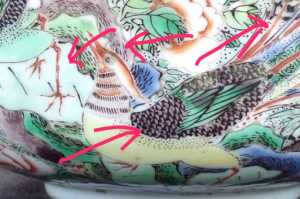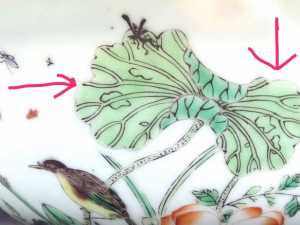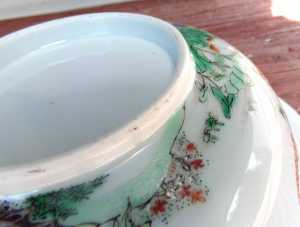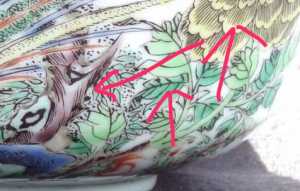The Chinese and Asian Art Forum. For Fans, Collectors and Dealers.
 Basic Rules For the BidAmount Asian Art Forum: Talk about whatever you want. You can even discuss and offer things that are for sale if they are authentic. Maximum image file size per post is 2 MB. Images of 700pxl x 700pxl are optimal if saved at a medium resolution. Be respectful of others and enjoy yourself. Click the YouTube link for a brief tutorial on using the forum. You can also EMBED Videos by cutting and pasting from You-Tube, Vimeo etc.
Basic Rules For the BidAmount Asian Art Forum: Talk about whatever you want. You can even discuss and offer things that are for sale if they are authentic. Maximum image file size per post is 2 MB. Images of 700pxl x 700pxl are optimal if saved at a medium resolution. Be respectful of others and enjoy yourself. Click the YouTube link for a brief tutorial on using the forum. You can also EMBED Videos by cutting and pasting from You-Tube, Vimeo etc.
NOTE: To post an item or add a new post, click open the category title from the FORUM LIST, and CLICK the Blue ADD TOPIC button.
Here’s the thing….
Famille verte is a Kangxi style, and from the early 20th c. onward, the preference and subsequent production of Qing style porcelains were/are decorated in Famille rose palate.
I suspect there are a few rare famille verte Republic period pieces, but I think that is a very rare exception. Post pics if you have examples to share… Inhave none to speak of.
So, looking further to the mid 20th c. to 3rd quarter, the translucent enamels do not match the opaque / dirty enamels, nor does the paste of Jamie’s bowl (which seems quite white and refined).
So, that leaves to question… is it post 1980’s? No.
Not only has Jamie stated that there is wear consistent with age, but you can see several areas of glaze retractions and imperfections that are quite typical of 19th c. decorations and wood kiln firing.
The idea that someone would try to recreate this bowl in modern time to deceive does not make economic sense… their is no visible indication that the design is intended to deceive the buyer of yes age or quality.
As for the crowded nature of the decor, it appears on only one side of the bowl, while the reverse side is only moderately decorated…. a practice of the 19th c. potters trying to meet the demands of European buyers.
Dare I say that this is a Kangxi revival piece? ….perhaps not. I certainly do not wish to stir the ires of my friend Giovanni.
Thanks Greeno170, Your comments are definitively more logical and in accordance with reality. I even dare say, (not that I'm trying to convince anyone the bowl is old, because I really don't care one way or the other), that if this bowl was made after WW 2, I will donate my entire fortune to charity, and do so standing butt naked on Time Square while humming a kazoo (Not that anyone would notice 🤣). Of course I hope it has value, because I did pay something for, but I am just trying to assess the information and separate the wheat from the chaff. Information and disinformation are both part of learning. Sincerely, JT
@loveli4236 Let us know if you have Peter look at it and feel like sharing what he has to say or if you find out more info through other channels. I'd be curious to see how it turns out.
@loveli4236 If the bowl was in perfect condition, I would guess the retail value would fall between $600-800, which is why I don’t think anyone would reproduce it to deceive.
Dear Greeno,
What you said here “… several areas of glaze retractions and imperfections that are quite typical of 19th c. decorations and wood kiln firing. The idea that someone would try to recreate this bowl in modern time to deceive does not make economic sense…” is not correct, be sure of that. Either regarding the glaze and regarding the economic sense, which is not valid for China. You can see very rarely seen items, those that needs research efforts, made in unique copy, not in series, and nevertheless they are fake, and of very high level. Sold at ridiculous prices. Don’t think about the economics in this field.
Dear Jamie, I am sure that your bowl is not Kangxi. I am saying Kangxi because that is the main period for famille verte and because of the style of the decoration.
You said that it has signs of age. Where do you see them? On famille verte, the weakest enamel is the iron red, on which you should see scratches and fading. By the pictures, I don’t see them.
What is really off, in the decoration of your bowl, are:
The shape of the peasants, especially the lower one with that big rounded chest.
The magnolia tree, represented in the “over the wall” style, i.e. looking as if the tree was going inside the bowl and branches coming out from there. Not seen on this type of bowls.
The millet with lotus leaves.
And others, unless the pictures are deceiving, because taken too close and hence distorting proportions.
Giovanni
@clayandbrush I do not think Jamie is claiming the bowl is Kangxi, but rather 19th c., as I am.
I suggested further investigation as to possible Kangxi age in my first post because (in part) I looked at the photos only briefly at the time, recognized the style as Kangxi, and did not want to pass judgement without considering all aspects of the bowl (glaze, design, paste, form).
The bowl is not Kangxi.
However, the genuine Kangxi bowl that Jamie's bowl is based upon might be worth $2,000. This hardly seems to be sufficient motivation to recreate it in modern times.
As pretty as it is, it has no mark, the form is purely utilitarian, and the size is relatively small.
It makes perfect sense to me that this was one of many made in the 19th c. to be used by a wealthy European family. It makes no sense to me why it would be made in the 20th c.
Yes, the Chinese fakers have the ability to recreate amazing modern copies (I have a few that I very much enjoy because I can not afford the real one!), but not this bowl.
I know I'm probably beating a dead horse, but the more I study the bowl, the more I like it.
I've got my Ipad out with a large screen so that I can zoom in on Jamie's photos....I think they are quite telling about the quality of the rendering, and that is telling of the age. Keep in mind this is an 8 inch wide bowl, so small scale and rounded surfaces...very hard to keep proportions correct on this kind of surface.
Look at the feet rendered in iron red - I see some wear, but more importantly, look how delicately rendered....very thin line work.
Look how detailed the scaling of the pheasants feathers....ever scale rendered individually.
Notice the top of the bird's beak has two fine hairs.... common detail to genuine pieces, often overlooked in copies.
Also, more wear seen in the iron red tail feathers.
If there is any concern of how the bird looks, I suspect it is only an optical illusion due to how photos capture images on curved surfaces.
Now, just look at the beautiful rendering of this lotus leaf....
It is important to notice the edges where the black lines thin and dissapear from one edge to the next....this creates a natural texture and depth to the leaf. The veins of the leaf also show line work that thickens and thons according to the contour of the leaf.
Ket me add that the positioning of insects is playful and subtle.
Look at how the glaze floats on the surface of the porcelain....gem like. This type of translucent green glaze was notorious for dripping and pooling, as can be seen in some spots, but overall, very well controlled.
Look at the tree trunk....horizontal lines that start thick, then tapper. This creates the illusion of a bend in the trunk or branch. Modern pieces either don't have tappering lines (uniform in thickness) or just don't have as many lines, and consequently don't capture the effect.
Similarly, the line work of the leaves are very detailed, follow the contour of the leaf, and taper from thick to thin.
And the flower's line work is, again, intensely fine....an abundance of perfectly drawn thin lines.
This is not a 20th c.
I can go on if you'd all like?
The only famille verte Republic piece that I have is an egg shell porcelain Lantern cover and base.
Not really a good comparison to this piece I’m afraid.
The Bowl is very nicely painted but appears to be too much of a good thing,as if the painter is actually showing off his mastery of the Kangxi style
There is a inbalance between the inside decoration of the bowl,which I love and could easily be Kangxi,and the overly busy exterior,which is very well painted but wholly overcrowded.
A piece to keep and come back to.
The Bowl itself could be Kangxi as well as the inside painting.
The exterior I have doubts.
All in all a bit of an attractive contradiction.
Vic
P.s I used to have a Kangxi famille verte pheasants Bowl which I sold quite a few years ago.
I’ll add pictures as there may be some on Gotheborg or my old computer.
Vic, after holding and examining the piece, I swear the inside and outside were fired at different times. I thought I was going crazy at first, but now I'm not so sure. Do you know of any antique examples that have modern overglaze enamels refired onto them? JT
@clayandbrush I was, naturally, referring to my Frankenstein bowl. I would like for you to hold it. JT
Jamie,
I recall seeing many 19th c Celadon ground Bowls with over painted famille rose family scenes,etc.
The outside decoration is totally new and very well done. Usually there is more wear to the Bowls than to the enamels,which can be Preston.
Vic.
@loveli4236 It certainly could have had decoration added (clobbering) at a later time, but I think the difference in how the inside is decorated vs. the outside decoration is a happy result of the 19th c. practice to over decorate the front, and refrain from a lot of decoration on the back.
Since your piece is s bowl, the artist treated the inside like the back… and showed restraint with the decor.
Our taste today is for more restrained designs…. In Victorian times, gaudy was the preference.
Some variation in the quality of the rendering may also be attributed to the flatter surface of the inside of the bowl being easier to decorate than the rounded/sloping exterior sides.
This is a very interesting discussion, I am enjoying following it. I now realise, thanks to some comments by Greeno, that the green area that looked bubbly had actually gone glassy like jewels as one sees on some 18th c famille rose pieces for example. I have not seen the aubergine run before, so that was interesting.
Sorry to be a pain but I would still like to know if the glaze has a bluish tinge as one can see in a couple of photos or is that a trick of the light? It might help to see some photos that are not over lit, is that possible, please?
Last question, I promise 😊 : in photos 13 and 17 the branch to the right of the picture as you look at it, has a strange colour on the underside - what colour is that? I can't make it out, nor can I see it elsewhere.
Thanks for visiting "The BidAmount Asian Art Forum | Chinese Art"
If you sell on eBay, or have a shop feel free to post images and descriptions and links.
Check back often for discussion about the latest news in the Chinese art and antique world. Also find out about the latest Asian art auctions at Sotheby's, Christie's, Bonhams and Tajans.
Auction results for: fine porcelain, ceramics, bronze, jade, textiles and scholar's objects. As well as Japanese, Thai, Vietnamese and other Asian cultures.
Thank you,
Peter Combs
Topics and categories on The BidAmount Asian Art Forum | Chinese Art
Kangxi vases, Kangxi dishes and chargers, Kangxi ritual pieces, Kangxi scholar's objects, Qianlong famille rose, Qianlong enamels, Qianlong period paintings, Qianlong Emporer's court, Fine porcelain of the Yongzheng period. Chinese imperial art, Ming porcelain including Jiajing, Wanli, Xuande, Chenghua as well as Ming jades and bronzes.
The BidAmount Asian Art Forum | Chinese Art
A free Asian art discussion board and Asian art message board for dealers and collectors of art and antiques from China, Japan, Korea, Thailand, Cambodia, Vietnam and the rest of Asia. Linked to all of the BidAmount Asian art reference areas, with videos from plcombs Asian Art and Bidamount on YouTube. Sign up also for the weekly BidAmount newsletter and catalogs of active eBay listing of Chinese porcelain, bronze, jades, robes, and paintings.
The art of calligraphy - and for the ancient Chinese it certainly was an art - aimed to demonstrate superior control and skill using brush and ink. Calligraphy established itself as one of the major Chinese art forms during the Han dynasty (206 BCE - 220 CE), and for two millennia after, all educated men were expected to be proficient at it.
The Museum’s collections of Asian art span nearly five millennia and encompass the cultures of China, the Himalayas, India, Japan, Korea, and Southeast Asia. In 2007, the Museum launched an initiative to create dedicated galleries for the collection, beginning with a gallery for the arts of Korea ...
Chinese art is full of symbolism, in that artists typically seek to depict some aspect of a totality of which they are intuitively aware.
China Online Museum is the finest online museum of Chinese art. It features Chinese calligraphy, painting, ceramics, bronzes, carving, and other artworks.
Chinese Ceramics & Works of Art. Overview Upcoming auctions Contacts Auction results ... Christie’s sales of Chinese ceramics and works of art showcase centuries of Chinese history. Held throughout the year in London, New York, Paris and Hong Kong, they attract a wide audience of collectors and connoisseurs vying for pieces as diverse as ...
Explore Asian Art Week. Contact the Specialist Department. Chinese Paintings ... Senior Specialist, Head of Sale. [email protected]. Tel:+1 212 641 5760. Bid in-person or online for the upcoming auction:Fine Chinese Paintings on 10 September 2019 at New York. Bid in-person or online for the upcoming auction:Fine Chinese Paintings on 10 ...
Discover an abundance of must-see art from all corners of a vast continent at Christie’s NY Asian Art Week. From contemporary classical and Chinese paintings to works with exemplary provenance from the Art Institute of Chicago, our Rockefeller Paza galleries will be full of ancient treasures and contemporary masterworks in a salute to the vibrant arts of Asia.
Sold to benefit The Art Institute of Chicago’s Asian Art Acquisition Fund, the sale features 84 lots with a focus on Ming and Qing porcelains, and offers a rare insight into the taste for collecting Chinese ceramics and works of art in the Midwest from the end of the 19th century through the 1980s. Highlights include two Wanli wucai garlic-head vases, a Qianlong mark and period, blue and ...
Specialist, Chinese Paintings, Christie's London Dr Malcolm McNeill is a Specialist in Chinese Paintings at Christie’s, based in London. He previously worked as an assistant curator of the Chinese collections and the Victoria and Albert Museum in London, as a researcher at the British Museum, and as a translator and tour guide at the National Palace Museum in Taipei.
The Christie's Education 2020 Conference: The Chinese Art Market 18 Jun 2019 Christie’s Education is delighted to announce our first international academic conference in Asia which will take place in Hong Kong from 26-27 November 2020 at the Hong Kong Convention and Exhibition Centre and will run in parallel with Christie’s Hong Kong Autumn Auctions.
The summer Chinese Art sale in Hong Kong will feature works of art from several private collections, including Qing porcelains and textile from the collection of the legendary Chinese art dealer A. W. Bahr (1877–1959), fine gilt bronze Buddhist sculptures from an old Hong Kong collection, an East Asian collection of Qing dynasty wine cups and jades, and a Japanese collection of Song ceramics ...
Sotheby's Chinese Works of Art Department holds two auctions each year in London, New York, Hong Kong and Paris.
Chinese Art - View Auction details, bid, buy and collect the various artworks at Sothebys Art Auction House.
With more than 340 Chinese works of art dating from the Neolithic to the Republic periods, highlights of this sale include a selection of Qing Imperial monochromes from the collection of Arnold and Blema Steinberg, early ceramics from the Art Institute of Chicago and Chinese porcelain and works of art from the collection of Henry Arnhold.
Results: Sotheby's Asia Week achieved $52.4 million in six strong auctions, exceeding pre-sale estimates. With 76.5% of lots sold and 60.3% of lots surpassing high estimates, the Asian art sales at Sotheby's indicate continued collector interest in the finest works of art from China, India and and the Himalayas.
Today's sale of Important Chinese Art will proceed as planned with sessions at 10 AM and 2 PM EDT. Sotheby's will be monitoring the weather conditions throughout the day and will be available to coordinate alternative bidding options should conditions make it difficult for clients to attend the auction in person.
Bonhams Chinese Art department is renowned for offering the finest works of art representing the richness and breadth of China's artistic heritage, particularly Imperial porcelain, white and spinach green jades, cloisonné and Buddhist art. Specialised international auctions are held globally, including London, Hong Kong and San Francisco.
Bonhams : Chinese Works of Art We use cookies to remember choices you make on functionality and personal features to enhance your experience to our site. By continuing to use our site you consent to the use of cookies. Please refer to our privacy and cookie policies for more information.
Bonhams Fine Art Auctioneers & Valuers: auctioneers of art, pictures, collectables and motor cars. We use cookies to remember choices you make on functionality and personal features to enhance your experience to our site. By continuing to use our site you consent to the use of cookies. ... Chinese Art (US) General enquiries
Bonhams : Fine Chinese Art We use cookies to remember choices you make on functionality and personal features to enhance your experience to our site. By continuing to use our site you consent to the use of cookies. Please refer to our privacy and cookie policies for more information.
Bonhams Fine Art Auctioneers & Valuers: auctioneers of art, pictures, collectables and motor cars Bonhams : Asian Art We use cookies to remember choices you make on functionality and personal features to enhance your experience to our site.
Bonhams are international auctioneers of fine Chinese and Japanese art. We specialise in rare Imperial and Export Chinese ceramics and works of art, as well as Japanese ceramics, fine and decorative works of art from the Neolithic Period to the 20th century. View on map
Bonhams Fine Art Auctioneers & Valuers: auctioneers of art, pictures, collectables and motor cars. We use cookies to remember choices you make on functionality and personal features to enhance your experience to our site. By continuing to use our site you consent to the use of cookies. ... Asian Art Bonhams. Work. 22 Queen St.




